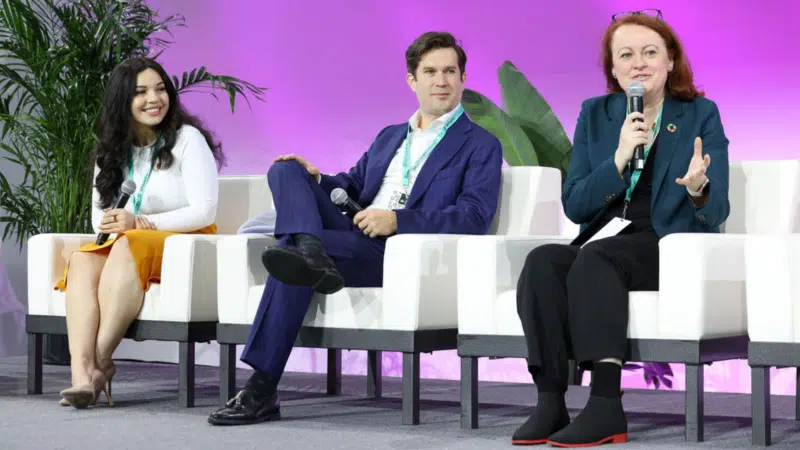Adtech’s approaches to greener marketing
Mastercard and HSBC Bank were among those discussing ways to reduce carbon emissions at the Green Media Summit.

The second-annual Green Media Summit at New York’s Javits Center last week showed the promise of greener pastures for marketers and customers concerned about harmful business practices overheating the planet. Leaders in the adtech industry gathered to discuss new tools and strategies that lead to more sustainable digital advertising.
“This year, our aim was to place a strong emphasis on actionable insights at the core of our discussions,” said Benoit Skinazi, CMO at Sharethrough, the programmatic adtech company hosting the event. “We were fortunate to feature industry leaders, climate experts, and storytellers who generously shared their experiences and recommendations for building a greener media ecosystem.”
Why we care. Clearly, there’s a disconnect between environmentally conscious consumers who want to buy green and stakeholders who think “ESG is a four-letter word.” Implementing a sustainable adtech solution is part of adopting a larger environmental mission that brands can communicate proudly to customers. But these improvements have to make business sense as well.
“For broader adoption of environmentally friendly digital advertising, it is crucial to promote the tangible benefits of green media products more vigorously,” Skinazi said. “As Martin Brian from IPG has aptly put it, we need to demonstrate that ‘purpose and profits’ are indeed compatible.”
Green adtech tool. At the summit, sustainable adtech company Scope3 introduced the GMP+ green media offering. By cutting out wasteful ads, it aims to bring efficiency to the ad supply chain, saving dollars and emissions for advertisers.
GMP+ is a standardized media offering that protects advertisers from wasteful programmatic ad placements. Ads that load outside the viewable area of a browser or reload frequently are examples of the digital ads GMP+ helps advertisers avoid because they waste money and increase the advertiser’s carbon footprint.
Flagging these ads is possible because of the Global Placement ID (GPID) standard. Sharethrough is the first adtech partner to make GMP+ available to media buyers and publishers through its programmatic platform.
The GMP+ improves on a previous iteration that reduced emissions by 25% by cutting out high-emission websites from the ad supply chain.
“[GMP+] creates a win-win situation,” said Skinazi. “It enables advertisers to place their ads on higher-quality inventory that is more efficient and has a lower carbon footprint. This approach not only delivers improved performance but also further reduces the environmental impact of advertisements.
Mastercard making team green. The adtech supply chain is part of a larger system that companies can impact by changing how they do business. Mastercard took steps to align internal ESG goals with employee performance. In 2021 they implemented an ESG bonus for executives. In 2022 they expanded the initiative by tying ESG goals to the performance score for all employees, including those in marketing.
“Sustainability is no longer a nice-to-have,” said Kellyanne Perez-Vera, sustainability manager, global media at Mastercard. “It is something that, going forward, everybody is going to be required to do because it’s the right thing to do…From an employee perspective, they can see that their company is tying compensation and goals and everything to this. The company morale was super happy and everyone is really engaged.”
HSBC Bank aligning green operations with portfolio. HSBC Bank adopted a net-zero approach not only internally but by measuring the emissions of its investments as well. The company pledged its operations will be net zero by 2030, and its portfolio by 2050.
To get there, HSBC Bank monitors “scope 3” emissions, which are created by the company’s value chain and not just the company itself. (The company Scope3’s name is a nod to this term.)
“Our operations are fairly lean,” said Matthew Cullinen, HSBC Bank’s VP of global sustainability. “For us as a bank, our scope 3 emissions are finance emissions. So all your emissions as clients, that’s our scope 3 emissions, as well as our 20,000 suppliers for various things we purchase. Fifty percent of our energy now comes from renewables. We have a target of 90% by 2025 which is challenging, but we’re well on our way to achieving that.”
Curbing marketing emissions. “We’re a financial services company so our scope 3 initiatives aren’t necessarily [what they would be for] consumer packaged goods, but that still doesn’t stop us,” said Mastercard’s Perez-Vera. “We do see that the bulk of our emissions comes from marketing and we are tackling that head-on. You have to dive in and do the best you can with the tools and information you have.”
She added: “When you really break out carbon emissions [in marketing], everything has a carbon footprint. Your media team has to get to work, your transportation has a carbon footprint. Going into the building in which you have a strategic meeting, lighting that building and that specific room, has a carbon footprint. So, what we’re doing as best as possible is vetting what tools, what products, what teams can help us in actually reducing, which can be tricky. And yes, digital is a hotspot, so it’s being intentional about our media and our production shoots to ensure that we are essentially being as optimal as possible.”
Green venue. The Green Media Summit was held in the Pavilion on the Farm at the Javits Center. The venue sits by the largest green roof in New York state, housing a one-acre working farm and 6.75 green acres total.
Dig deeper: Adtech’s climate change: Can marketing cool the planet?
Related stories
New on MarTech